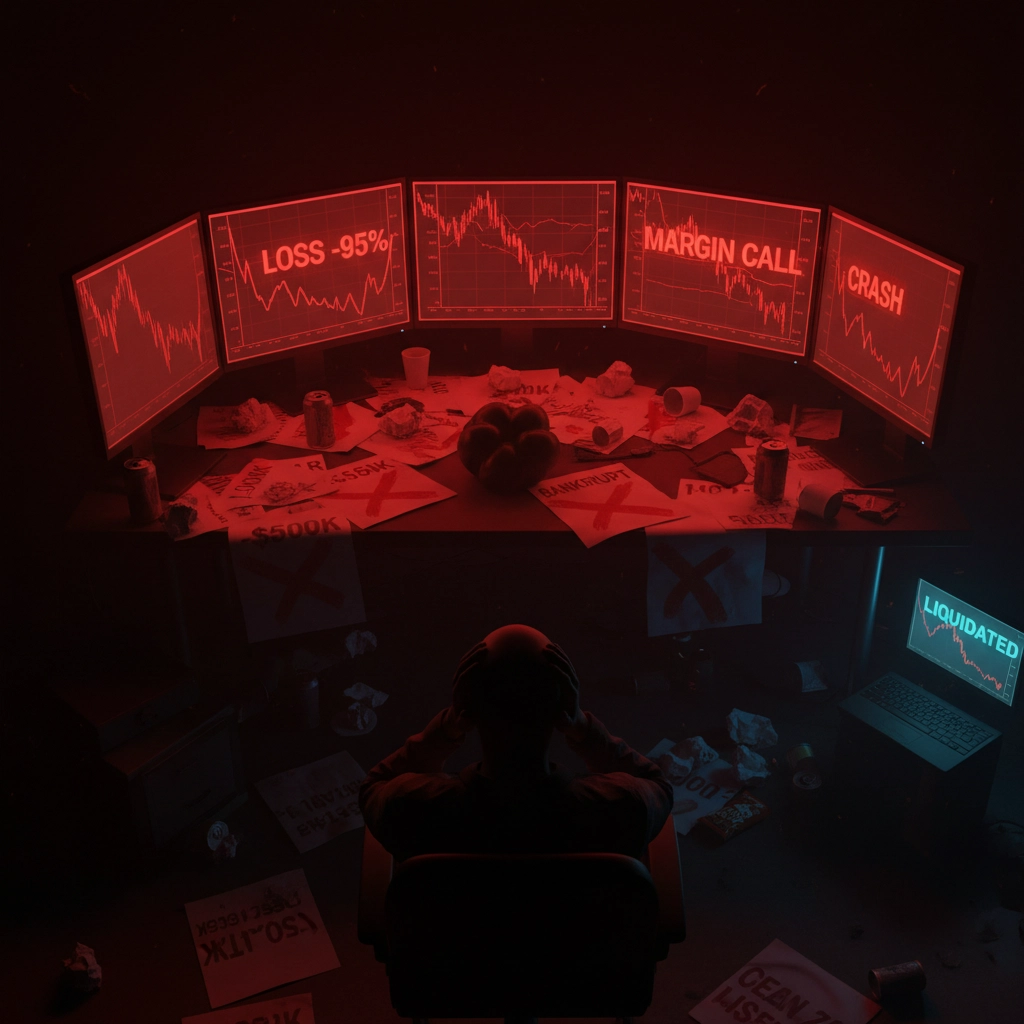Let’s cut straight to the chase: 80% of new traders quit within their first two years, and most lose their entire accounts in the first year alone. That’s not a scare tactic: it’s cold, hard market reality.
But here’s the thing: this failure rate isn’t inevitable. It’s the predictable result of specific, preventable mistakes that destroy trading careers before they even begin. The difference between the failing 80% and the successful 20% isn’t luck, natural talent, or market timing: it’s understanding and implementing fundamental principles that most trading education completely ignores.
After training thousands of traders and seeing both spectacular failures and incredible successes, I’ve identified the exact patterns that separate winners from losers. More importantly, I’ve developed a system that addresses every single one of these failure points head-on.
The Emotional Death Spiral That Kills Accounts
The number one account killer? Revenge trading. Here’s how it works: a trader takes a loss (completely normal), but instead of sticking to their plan, they tell themselves “just one more trade to get it all back.” They double down, increase position size, and abandon every rule they know. Before they realize what’s happening, a manageable 2% loss becomes a complete account wipeout.

This isn’t a character flaw: it’s human psychology. Our brains are literally wired to make terrible trading decisions. When we’re losing money, we feel physical pain. Our fight-or-flight response kicks in, and logical thinking goes out the window.
The worst part? Early wins make this problem even worse. New traders who get lucky in their first few trades develop what I call “beginner’s arrogance.” They mistake random market movements for skill and start taking bigger risks with less analysis. Then reality hits, and it hits hard.
At Samuel & Co Trading, we don’t just teach technical analysis: we spend serious time on trading psychology because mindset separates profitable traders from the 80% who fail. Our mentorship program specifically addresses emotional trading patterns before they destroy accounts.
Risk Management: The Non-Negotiable Foundation
Here’s a brutal truth: poor risk management is the primary reason 80% of traders leave the market. Most traders enter positions thinking about potential profits while completely ignoring potential losses. They’re playing Russian roulette with their financial future.
Professional traders approach every trade by first asking: “How much can I lose?” They set stop losses, calculate position sizes, and implement controls before even considering potential profits. Amateur traders do the exact opposite: they chase big wins while ignoring big risks.
Leverage makes this problem exponentially worse. While leverage lets you control larger positions with smaller capital, it’s also one of the main reasons traders lose entire accounts. In forex trading, where leverage can be 100:1 or higher, up to 90% of traders lose money. They simply don’t understand that leverage is a double-edged sword that can wipe out accounts in minutes.

Stop loss placement is another disaster area. Traders set stops based on fear or greed rather than logical analysis: either too close (getting stopped out of winning trades) or too far (hoping for impossible reversals that never come). Both approaches systematically drain trading capital.
This is why our Ofqual-accredited trading courses start with risk management fundamentals. We don’t let students trade live until they can demonstrate proper position sizing and risk controls. It’s not exciting, but it’s what keeps traders alive.
The Education Gap That Costs Fortunes
Between 70-80% of retail traders lose money because they enter markets with insufficient education, believing trading offers a quick path to wealth. The reality? 90% of beginner traders lose their capital within a short period primarily due to inadequate trading education.
Most trading education focuses on indicators, patterns, and “signals.” That’s like learning to drive by only studying the speedometer. You need to understand market structure, economic fundamentals, institutional behavior, and money flow: not just pretty lines on charts.
Even worse, most traders operate without any defined strategy. They take trades based on “gut feeling” or because they’re bored. They overtrade, chase momentum, and make decisions based on hope rather than analysis. If you feel like you need to trade ten times daily to be a “real trader,” you’re already losing.

Our approach at Samuel & Co Trading is different. We don’t just teach technical patterns: we provide comprehensive market education covering:
- Institutional trading concepts that retail traders rarely learn
- Economic fundamentals that drive long-term price movements
- Market psychology and crowd behavior
- Real-world trade management from entry to exit
The Overtrading Death Trap
Overtrading destroys more accounts than any single factor. It combines increased transaction costs, reduced trade quality, and emotional exhaustion into a perfect storm of capital destruction.
The urge to constantly trade comes from boredom, impatience, or the desperate need to recover losses quickly. But here’s what successful traders know: real money comes from learning patience. The market doesn’t care if you’re bored or anxious to trade. It only rewards traders who wait for high-probability setups that align with their strategy.
Nearly 40% of day traders quit after just one month. They enter thinking they’ll make quick profits through constant activity, then reality hits. They’re paying spreads and commissions on every trade while taking low-quality setups just to feel active.
Professional traders might only take 2-3 trades per week, but each trade is carefully planned and executed. They understand that trading less often with higher conviction beats trading frequently with poor setups every single time.
How Samuel & Co Trading Addresses Every Failure Point
Here’s where most trading education fails: it treats symptoms instead of root causes. Students learn patterns and indicators without understanding why they work or when they fail. They get “strategies” without learning proper execution or risk management.
Our comprehensive trading courses take a completely different approach:
Real-World Mentorship: You’re not learning from theoretical instructors: you’re learning from traders who’ve been in the trenches and built successful careers. We share actual trade examples, real losses, and honest discussions about what actually works versus what sounds good in marketing materials.
Psychology-First Education: Before you learn a single technical indicator, you understand the psychological traps that destroy accounts. We address revenge trading, overconfidence, and emotional decision-making from day one.
Institutional-Level Concepts: Retail traders typically learn retail strategies. We teach you how institutions think and move markets, giving you a massive edge over typical retail approaches.
Ongoing Support: Trading education isn’t a one-time event: it’s an ongoing process. Our mentorship continues long after course completion, helping you navigate real market conditions with experienced guidance.

Ofqual Accreditation: Our courses meet rigorous educational standards, ensuring you’re getting legitimate, comprehensive training rather than get-rich-quick schemes.
What Actually Works: The Foundation for Long-Term Success
Successful trading isn’t about finding the “perfect strategy” or the “secret indicator.” It’s about building a solid foundation based on principles that have worked across all market conditions and time periods.
This foundation includes three non-negotiable elements:
- A tested strategy with clear entry and exit criteria
- Unwavering discipline to follow the strategy even during losing streaks
- Patience to wait for setups that truly match your criteria
The strategy should be based on solid market principles, not hope or guesswork. Discipline ensures you follow your plan when emotions try to take control. Patience allows you to avoid low-quality trades that drain accounts.
Trading journals and performance analysis separate professionals from amateurs. Successful traders track every trade, identify patterns in their wins and losses, and make data-driven improvements rather than emotional adjustments.
The Path Forward: Join the Successful 20%
The 80% failure rate isn’t written in stone: it’s the result of specific, correctable behaviors. New traders who dedicate time to proper education, implement strict risk management, control their emotions, and resist get-rich-quick thinking dramatically improve their odds of success.
The markets reward preparation, discipline, and patience while ruthlessly punishing impulsiveness, overconfidence, and emotional decision-making. This isn’t opinion: it’s observable market behavior that’s been consistent for decades.

At Samuel & Co Trading, we’ve developed a comprehensive approach that addresses every major failure point new traders face. Our Ofqual-accredited courses provide the education, mentorship, and ongoing support needed to join the successful 20% rather than become another casualty statistic.
Don’t let yourself become part of the 80% who fail. The market will always be here, but your capital won’t if you don’t approach trading with the seriousness and preparation it demands.
Ready to learn what actually works? Explore our comprehensive trading courses and discover why our students consistently outperform market averages. Your future self will thank you for making the investment in proper education now rather than learning these lessons through expensive market tuition later.






